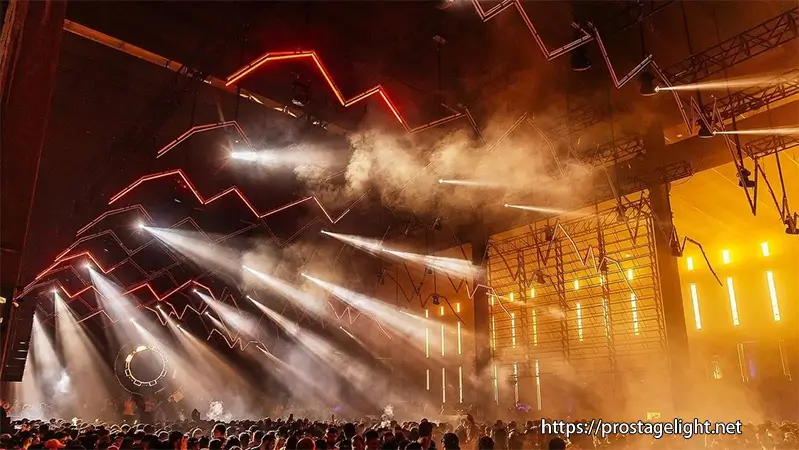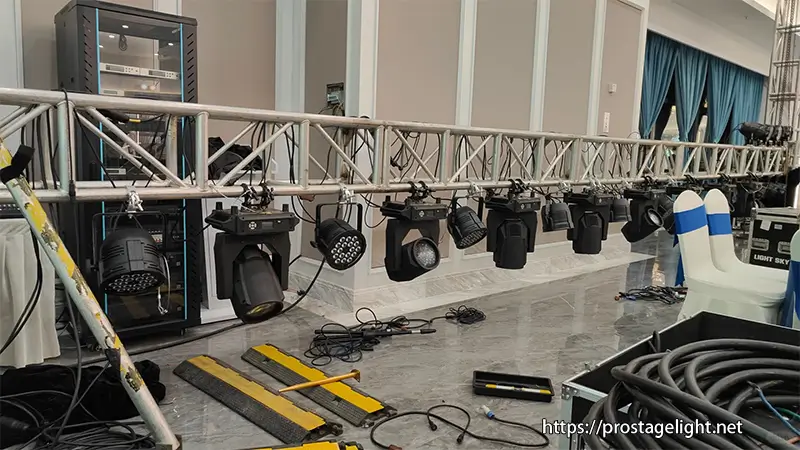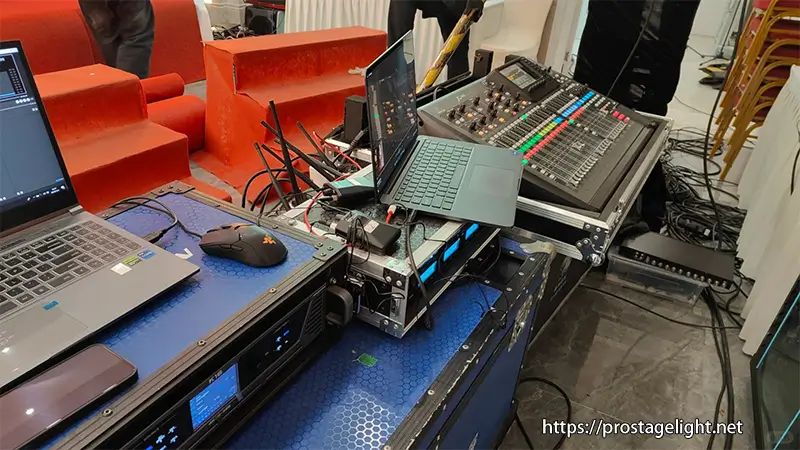Introduction to Stage Lighting
The Role and Importance of Lighting in Stage Production
The transformative and essential nature of stage lighting serves as a bridge between performers and the audience, effectively communicating a powerful visual language that speaks volumes without the need for words. From its humble beginnings with simple candlelight to the complex, computer-controlled systems of today, the evolution of stage lighting mirrors the journey of theatrical expression itself. This journey has not only enhanced the visual spectacle but has fundamentally altered how stories are told, emotions are conveyed, and experiences are crafted for the audience. Lighting does more than illuminate; it shapes the entire atmosphere of a production, guiding the audience's focus, and enhancing the narrative and emotional depth of the performance.
Understanding the Basics: Key Terms and Concepts
Navigating the world of stage lighting begins with a grasp of its vocabulary and the roles of various lighting types. Terms like 'lumens,' 'wash,' and 'spot' articulate the intensity, distribution, and focus of light, essential for crafting the desired visual effect. Each lighting type, from the broad wash of floodlights to the precise beam of spotlights, serves a specific purpose, sculpting the space and directing attention. Understanding these basics lays the foundation for delving into the more nuanced aspects of lighting design and application.

Essential Stage Lighting Equipment
Types of Stage Lights
In the dynamic world of stage lighting, the variety and capabilities of lighting equipment continue to evolve, offering designers an expansive toolkit for creativity and expression. Beyond the foundational spotlights, floodlights, and LED Par Cans, modern productions increasingly leverage specialized lighting types to bring their visions to life.
Stage Moving Head Lights
Moving head lights stand out for their versatility and dynamism. Equipped with motors that allow the lights to tilt and pan, these fixtures can sweep across the stage or audience, creating lively effects that enhance the energy of a performance. With features like color mixing, gobos for pattern projection, and adjustable focus, moving head lights are indispensable for productions that demand precise, animated lighting sequences.
Stage Laser Lights
Laser lightsbring a distinct intensity and sharpness to stage lighting designs. Capable of cutting through the darkest scenes with vibrant, concentrated beams, lasers are used to create striking visual effects, from geometric patterns to simulated starfields. Their ability to project over long distances without losing intensity makes them a favorite for concerts, club events, and outdoor performances.
Stage Special Effects
Special effects lighting encompasses a wide range of tools designed to add texture, movement, and atmospheric effects to a stage. This includes:
Strobe Lights: For creating rapid flashes of light, adding energy or dramatizing moments.
Fog and Haze Machines: By incorporating lighting, these machines have the ability to improve the visibility of beams, resulting in a tangible perception of depth and space.
UV Lights: These bring out vivid colors, especially whites and neons, adding a surreal or otherworldly quality to scenes.
The versatility and intricacy of modern stage lighting design is showcased through the countless combinations and applications of various lighting types and effects, allowing for a tailored support of the narrative and emotional journey of a performance.
Lighting Control Systems
The heart of modern lighting design lies in its control systems. DMX control, lighting desks, and software form a nexus of command, enabling precise manipulation of lighting elements across the spectrum. This control is crucial for synchronizing lighting effects with the unfolding action, ensuring that each cue hits with pinpoint accuracy, enhancing the drama and emotional impact of the performance.
Accessories and Hardware
Beyond the lights themselves, a myriad of accessories and hardware—gels, gobos, clamps, and trusses—play pivotal roles in refining and supporting the lighting design. Gels color the light, gobos create patterns and textures, clamps secure lights to rigs, and trusses provide the structural backbone for mounting equipment. Together, these elements allow for a level of customization and creativity that can transform any stage into a vivid, immersive world.

Advanced Lighting Techniques and Design
Crafting the Mood and Atmosphere
Lighting is the alchemist of the stage, capable of turning the mundane into the magical, the static into the dynamic. Through the strategic use of color, intensity, and angle, lighting designers wield the power to evoke a spectrum of emotions and atmospheres, from the subtle shifts of daylight to the stark contrasts of a stormy night. This manipulation of light and shadow plays a crucial role in conveying the emotional and thematic undertones of a performance.
Dynamic Lighting Effects
The evolution of lighting technology has ushered in an era of dynamic lighting effects that can add texture, movement, and depth to a performance. Gobos and intelligent lighting work in concert to create mesmerizing patterns, simulate natural phenomena, or imbue the stage with kinetic energy, adding layers of visual interest and complexity to the production.
Integrating Visual Technology
The integration of visual technology with traditional stage lighting represents a significant shift in how performances are designed and experienced. This fusion extends the visual canvas beyond the physical stage, opening up new possibilities for storytelling and audience engagement.
Video Projections
Video projections can transform any surface into a dynamic visual element, from subtle background textures to intricate scenes that interact with live performers. By blending projection mapping technology with traditional stagecraft, designers can create immersive environments that defy the limitations of physical space.
LED Walls
LED walls are renowned for their unmatched brightness and color depth, making them the perfect choice for crafting vibrant backgrounds or enhancing the visual spectacle of any performance. Their modular nature allows for flexible configurations, from flat screens to curved surfaces that envelop the stage or audience.
Interactive Technologies
Incorporating interactive technologies, such as motion sensors and live video feeds, enables real-time responsiveness in lighting and visual effects. This interactivity can create a sense of magic, as the environment reacts to the movements and actions of performers or even the audience, fostering a deeper connection between the spectacle and its viewers.
Augmented and Virtual Reality
Augmented Reality (AR) and Virtual Reality (VR) are pushing the boundaries further, offering new ways to blend the physical and digital worlds. While still emerging in stage design, these technologies promise to offer audiences not just a seat to a performance but a doorway into entirely new dimensions of experience.
The integration of visual technology with stage lighting is not just an enhancement; it's a revolution in how stories are told and experienced. As these technologies continue to evolve, so too will the possibilities for creators and audiences alike, marking an exciting frontier for the art of stage production.

Conclusion
The realm of stage lighting is one of endless innovation and creativity, where technology and artistry meet to elevate storytelling to new heights. From the foundational equipment and techniques to the latest trends and technologies, the journey through stage lighting is a testament to the power of light to transform, captivate, and inspire. As we continue to push the boundaries of what is possible, the future of stage lighting promises even greater opportunities for expression, experimentation, and exploration. Whether you are just beginning your journey or are looking to deepen your expertise, the world of stage lighting offers a rich and rewarding path for those willing to venture into its luminous depths.
Frequently Asked Questions
Q1: What are the basic types of stage lights?
A1: The basic types of stage lights include spotlights, which are used to highlight specific areas or performers; floodlights, which provide general lighting over a wide area; LED Par Cans, which offer vibrant, energy-efficient color washes; and intelligent lighting, which includes moving head lights and other fixtures that can be programmed for dynamic effects.
Q2: How do moving head lights enhance a performance?
A2: Moving head lights enhance performances by providing dynamic, versatile lighting effects. They can pan, tilt, and change colors, patterns, and beam shapes, allowing for intricate and animated lighting designs that can follow the action on stage, create mood, or highlight specific moments.
Q3: What role do laser lights play in stage lighting?
A3: Laser lights play a significant role in creating visually striking effects due to their intense, focused beams. They are often used to generate patterns, atmospheric effects, or to accentuate music and action, adding a layer of excitement and precision to lighting designs.
Q4: Can you explain the importance of stage special effects lighting? A4: Stage special effects lighting, including strobe lights, fog/haze machines, and UV lights, add texture, depth, and atmosphere to a performance. They can simulate natural phenomena, enhance the visibility of light beams, create dramatic entrances, or transform a scene's mood, contributing to a more immersive and engaging audience experience.
Q5: How do video projections and LED walls integrate with traditional stage lighting?
A5: Video projections and LED walls integrate with traditional stage lighting by expanding the visual storytelling toolkit. They can display detailed scenery, backgrounds, or animations, working in tandem with traditional lights to create layered, immersive environments. This combination allows for greater creativity in design, enabling the creation of dynamic, evolving visual landscapes that complement the narrative and emotional flow of the performance.
Q6: What are the advantages of using interactive technologies in stage lighting?
A6: The utilization of interactive technologies in stage lighting, including motion sensors and live video feeds, enables a remarkable level of real-time responsiveness. This allows the lighting and visual effects to seamlessly adapt to the on-stage action or audience interaction with instant precision.This creates a more engaging, personalized experience, as the environment can change based on movement, making performances more dynamic and immersive.
Q7: How are augmented and virtual reality being used in stage design?
A7: The utilization of Augmented and Virtual Reality (AR and VR) in stage design allows for the creation of enriched or completely novel environments that seamlessly blend physical and digital components. This can transport audiences to different worlds or provide them with interactive, multi-sensory experiences that go beyond traditional viewing, offering new ways to engage with and interpret performances.
Q8: What should be considered when planning a lighting design for a stage production?
A8: When planning a lighting design, consider the narrative and emotional goals of the production, the available equipment and technology, the physical space of the venue, and how lighting will interact with other elements like set design, sound, and performer movement. Budget, safety protocols, and the technical capabilities of the team are also crucial factors to ensure the design is both effective and executable.
Q9: Are there sustainable practices in stage lighting?
A9: Yes, sustainable practices in stage lighting include using energy-efficient LED fixtures, employing lighting control systems to minimize power waste, and considering the environmental impact of lighting design choices, such as reducing the use of disposable materials and opting for equipment with longer life spans.
Q10: How can someone get started in stage lighting design?
A10: Embarking on a journey in the realm of stage lighting design generally requires a blend of educational pursuits, practical involvement, and establishing connections. While formal training in theater technology or lighting design is beneficial, gaining first-hand experience by participating in an actual production (even in a menial or volunteer role) can be invaluable. Additionally, forging connections with industry experts through internships, workshops, and affiliations with professional organizations can pave the way for new prospects and ongoing growth.
